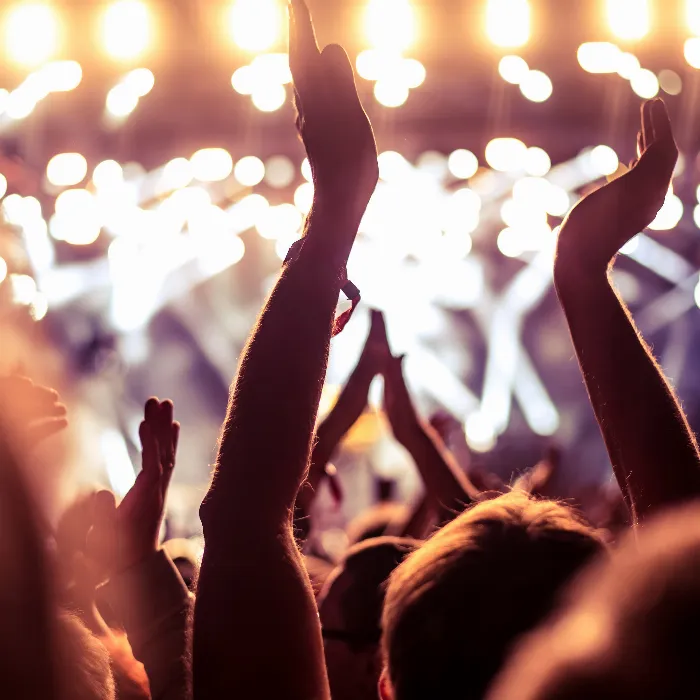Here is an overview of the individual chapters:
Part 01 - "Dream job" concert photographer?
Part 02 - Legal issues
Part 03 - Special features of concert photography
Part 04 - Behavior in the "trench"
Part 05 - The right equipment for concert photographers
Part 06 - Tips and tricks from (concert photography) professionals
Part 07 - Image composition (Part 1)
Part 08 - Image composition (Part 2)
Part 09 - Recommended camera settings
Part 10 - Post-processing
In concert photography, we photographers are merely "tolerated" - for reasons of press freedom, reporting, marketing etc.. We are not popular with anyone: neither with the musicians, their management, the organizer, the security or the fans in the audience. This is understandable, at least on closer inspection:
The musicians aren't really thrilled when we perform in the pit in close proximity to them (often the musicians are "within touching distance"). Imagine you have to give a speech in front of an audience or play a concert and there are lots of photographers scurrying around right in front of you. It's distracting, it's distracting!
The managers don't like us either (unless they need up-to-date photos of their "protégés"). We might take (and publish!) photos that the management doesn't like (unflattering poses of the artists, visible sweat stains, grim facial expressions, etc.). The management would prefer to control everything in order to prevent negative reporting (which also includes unflattering photos). But that's not possible with press photographers; and that's why they see us as a necessary evil and not as supporters in publicizing their contracted musicians.
The organizers would also be happy if we didn't exist, because we do "work" (in terms of organizational matters). Because of us photographers, inquiries have to be processed and checked, accreditations issued, press pit credentials printed and handed out and much more.
And the security in the trench also sees us as troublemakers. Because we make their job of providing security a little more complicated.
And last but not least, we also - unintentionally - disrupt the enjoyment of the many spectators, at least those in the front rows, whose view we block. And even if we don't block anyone's view, for example because the stage is raised, we distract from the actual action on stage by changing position etc.
Figure 4.1: Culcha Candela on August 20, 2011 at the Zeltfestival Ruhr in Bochum/Witten. Here you can see the press pit, in which there are still a few photographers at the far end, while the rest of us have already been led out by security (perhaps the term "pushed out" would be more appropriate). I took the photo at the "last look back", so to speak, as a last chance to take a photo of the scenery. And immediately afterwards, the other photographers were also "escorted" out of the trench.
Sometimes photographers are allowed to remain in the audience for the rest of the concert after the first three songs (where photography is permitted). However, this is always on the condition that the camera is left packed in the photo bag. Nikon D3S with 4.0/24-120 mm Micro Nikkor, with 24 mm focal length used. 1/60 second, Blender 4.0, ISO 3200.
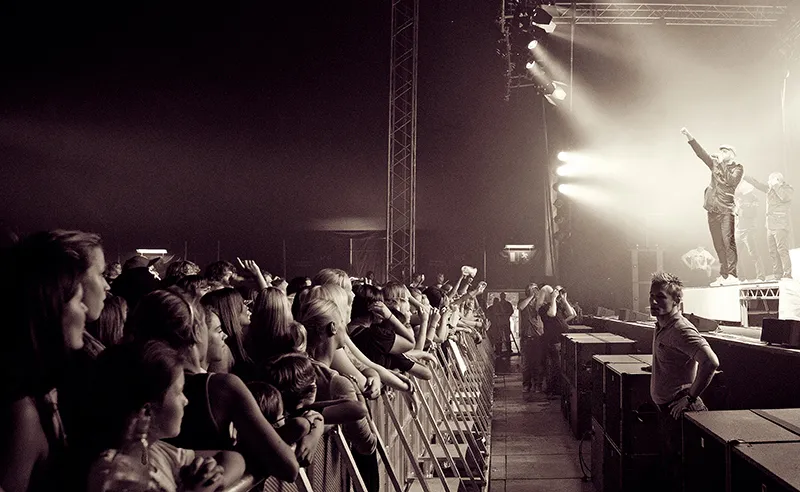
(Foto © 2011: Jens Brüggemann – www.jensbrueggemann.de)
Abbildung 4.2: Ist die Bühne nur minimal höher als der Pressegraben, ist die Perspektive für uns Fotografen vorteilhafter, weil wir nicht alle Fotos so sehr von unten aufnehmen müssen. Allerdings versperren wir so den Fans in den ersten Reihen natürlich deutlich stärker die Sicht auf die Künstler. H-Blockx am 31. August 2010. Nikon D3S mit 2,8/24-70-mm-Mikro-Nikkor, bei verwendeter Brennweite 24mm. 1/200 Sekunde, Blende 2,8, ISO 5000.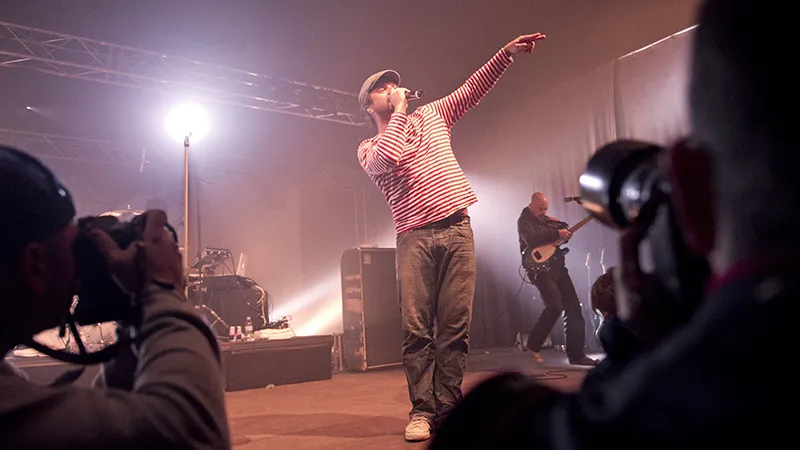
(Foto © 2010: Jens Brüggemann – www.jensbrueggemann.de)
4.1 Unauffällig agieren
Aus den oben aufgeführten Gründen ist es natürlich ratsam, im Pressegraben möglichst unauffällig zu agieren! Schließlich möchten wir niemanden stören. Man muss sich immer vor Augen halten, dass wir insofern „privilegiert“ sind, weil wir ja – zumindest eine kurze Zeit – kostenlos der Veranstaltung beiwohnen können. Und das sogar noch in exquisiter Position, ganz dicht an den Musikern, direkt vor der Bühne.
Die „Stars“ sind aber die Musiker, das sollten die Fotografen niemals vergessen! Ich habe leider schon Fotografen („Selbstdarsteller“) erlebt, die – im Hochgefühl, in Partystimmung – sich selbst im Pressegraben „gefeiert“ haben, indem sie sich zum Publikum umgedreht haben, in Siegerpose „Selfies“ von sich (mit den Musikern auf der Bühne im Hintergrund) gemacht haben und diese Selbstporträts dann sofort auf facebook oder anderen „sozialen“ Netzwerken gepostet haben. Eigentlich total peinlich sowas …!
Etablierte, erfahrene Konzertfotografen würden so etwas niemals tun. Denn denen geht es darum, außergewöhnliche, qualitativ hochwertige Fotos vom Konzert zu machen. Und ein verlässlicher Geschäftspartner für die Musikbranche zu sein, der unauffällig, effizient und gut seinen Job macht. Eine angenehme (und im Pressegraben auch „unauffällige“) Zusammenarbeit ist die Voraussetzung dafür, dass der nächste Akkreditierungswunsch bei kommenden Konzertveranstaltungen abermals positiv beschieden wird. Ein Fotograf hingegen, der unangenehm und störend aufgefallen ist, wird so schnell nicht wieder akkreditiert werden, zumal sich ein solches Verhalten auch innerhalb der Musikszene herumsprechen wird und so auch andere Veranstalter über die „schwarzen Schafe“ innerhalb der Fotografengemeinschaft informiert werden.
Abbildung 4.3: Jan Delay mit Band (und etlichen Konzertfotografen) am 20. August 2010 beim Zeltfestival Ruhr. Ein Künstler während des Konzertes braucht den Blickkontakt zum Publikum, um die Reaktionen zu sehen (ob sie „mitfeiern“ oder ob der Funke noch nicht übergesprungen ist). Das ist ganz wichtig, um entsprechend agieren zu können und um eine professionelle Show abliefern zu können. Fotografen, die sich zu auffällig verhalten, würden dabei nur ablenken, gegebenenfalls den Künstler nervös machen und dadurch letztendlich die Qualität des Konzertes beeinträchtigen. Nikon D3S mit 2,8/24-70-mm-Mikro-Nikkor, bei verwendeter Brennweite 24mm. 1/250 Sekunde, Blende 3,5, ISO 5000.
(Photo © 2010: Jens Brüggemann - www.jensbrueggemann.de)
Figure 4.4: Many enthusiastic (paying!) fans (here at the Culcha Candela concerton August 20, 2011) stand behind us concert photographers. They are looking forward to the performance of their idols and want to enjoy the concert as undisturbed as possible. So it goes without saying that we photographers in the pit should be as inconspicuous as possible!
This means, for example, not unnecessarily blocking the view of the stage and changing your position from time to time so that you're not standing in front of the same audience the whole time (and restricting their view - at least partially). Nikon D3S with 4.0/24-120mm Nikkor, with 24mm focal length used. 1/320 second, Blender 4.0, ISO 3200.
(Photo © 2011: Jens Brüggemann - www.jensbrueggemann.de)
Conclusion: Actually a matter of course, and yet occasionally photographers can be observed who are so brazen and do not stick to it: When taking photos in the press pit, concert photographers have to behave as inconspicuously as possible. It is important not to interfere with the show that is taking place on stage (and not in front of it). For the professional musicians (and their management and the concert promoters), this is how they earn their living. To achieve this, the show must run as smoothly as possible. Photographers who are a nuisance hinder the professionals in earning their income - and I think it's understandable that they can't take a joke.
The audience, on the other hand, also want to see a great show. They want to spend a few enjoyable hours and have paid (dearly) for it. They want to see their idols live on stage - and not self-promoting photographers.
4.2 Collegial behavior
Because there is usually comparatively little space for the photographers in the press pit (and often enough "tripping hazards" lying around on the unlit floor), the lighting conditions are extremely difficult and unpredictable (see previous tutorial, chapter 3.3) and the duration of the photo shoot is so severely limited (usually to the first three songs) (- time pressure!), most concert photographers feel totally "rushed" because they have to "shoot" at least a few successful photos within the short time available and despite the difficult conditions.
This pressure is all the greater, by the way, if the photographer earns his or her living with photography and cannot afford to go to the editorial office without usable ("printable") results.
This feeling of being rushed often leads to the otherwise friendly and reserved, sometimes even rather shy photographer suddenly turning into a "raging beast" when entering the press pit, defending his or her promising position with elbow grease and "storming" new positions at the edge of the stage as the concert progresses, regardless of other photographers who are already taking pictures there.
However, as so often in life: Friendly, collegial behavior ultimately yields more than "lone wolf tactics". You always meet several times in life (this is especially true in concert photography), and if you meet colleagues with whom you are on friendly terms at the start of a concert, this is guaranteed to be more pleasant than if you get a nasty look because of the jostling at the last concert and have to worry that you are now the one who can't expect any consideration from the other photographers.
Conclusion
So: behave like a colleague, in the end you'll get further than with inconsiderate behavior! And if you get a painful blow to the head from your neighbor's lens (as has happened to me), don't automatically assume that this was done on purpose. It is also possible that the photographer was so engrossed in composing the picture that the second camera unintentionally described too large an arc when panning around or changing lenses.
Figure 4.5: This photo was taken at a performance by Sunrise Avenue on August 27, 2012. The two photographers in the foreground are exemplary, leaving enough space for each of them to take photos undisturbed. However, the photography conditions in the trench are not always as "comfortable" as here: There is often a dense, uncomfortable crowd. I'm sure every concert photographer has been elbowed in the side or had a lens knocked against their head ... Unintentionally, of course, but no less painful for that. But then it's important to stay cool and spend the rest of the time available taking photos; the laceration on the head can be treated a few minutes later. After all, if you take successful, extraordinary photos from the concert, the wound will hurt a lot less! Nikon D4 with 2.8/14-24 mm Nikkor with a focal length of 14 mm. 1/500 second, aperture 2.8, ISO 4000.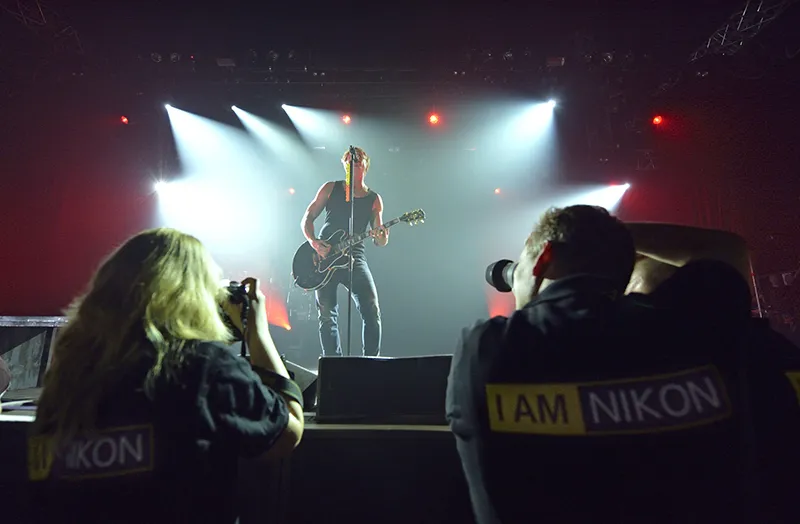
(Photo © 2012: Jens Brüggemann - www.jensbrueggemann.de)
4.3 (Safety) instructions
When accrediting, photographers often receive an information sheet from the organizer or at least verbal instructions on what is and is not allowed when taking photos during the concert. Stick to it!
Typical (safety) instructions are for example:
When are the photographers allowed into the press pit (usually only a few seconds before the concert starts). How long (3 songs?) are the photographers allowed to take pictures? The use of flash during the concert is prohibited. Are only certain positions allowed or are photographers allowed to move freely in the press pit? It is forbidden to use the edge of the stage to support the camera when taking photographs. Items (jackets, photo backpacks, etc.) may not be placed on the edge of the stage or on boxes.
Security has the authority to issue instructions and may - in the event of an emergency or for safety reasons - further restrict the powers of photographers granted before the start of the concert on a case-by-case basis. Photo bags may not be placed on the floor (risk of tripping for other photographers!). Flashlights may not be used in the press pit. After taking photographs, all photographers must leave the event room as a group. If they hand in their cameras, they may then attend the rest of the concert free of charge (but no longer in the press pit, but in the audience). Etc. (There are many guidelines and safety instructions; I have only listed a few typical ones here). If there are restrictions, they usually result from the fact that safety aspects have to be taken into account or that the organizer has received strict instructions from the musicians or their management as to what the photographers should and should not be allowed to do. In the first case, when it comes to safety and the smooth running of the concert, it goes without saying that these instructions must be followed. No one wants to be responsible if, for example, rescue workers are hindered in rescuing injured people through his or her fault.
In the second case, fairness dictates that we adhere to the guidelines so as not to "mess up" the organizer, who in this case stands as a kind of buffer between photographers and musicians. After all, he is responsible to the musicians and their managers, and if photographers do not adhere to the rules, musicians or management will accuse the organizer of breach of contract (and, if necessary, claim damages or demand a previously agreed contractual penalty).
Since the photographers enter into a contractual relationship with the concert organizer, because accreditation under conditions is nothing else, only the organizer can ensure that they act in accordance with the agreements in the press pit (or on the entire concert site). Musicians and management, on the other hand, will accuse the concert organizer of breach of contract if, for example, the photographers behave differently than agreed between the musician/management and the concert organizer, because the latter is responsible for what happens during the concert:
Customary contractual relationship:
Musicians/management <-> concert organizer <-> concert photographer
This means that the concert organizer is merely implementing the strict requirements of the musicians or their management. Or impose further regulations on the photographers for organizational or security reasons. In the event of non-compliance, the photographers cannot "take the blame" for this on their own responsibility, but rather directly harm the concert organizer. And thus the one who will organize concerts again at some point and where we photographers will then ask for (free) accreditation again ...
Figure 4.6: Tokio Hotel with singer Bill Kaulitz on April 05, 2007 in Warsaw. The word "fan" comes from "fanatic" and so it is clear that musicians are often concerned that the audience cannot get too close to them, as enthusiastic fans have often climbed onto the stage to touch their idol, hand over a plush teddy personally or give him or her a hug. This can sometimes throw the artist off his or her stride and interrupt the carefully planned show. To avoid this, the concert organizer must take the prevention of such dangers into account in his safety concept (and put it into practice accordingly). We photographers must then also adhere to this, because safety and the smooth running of the show come first!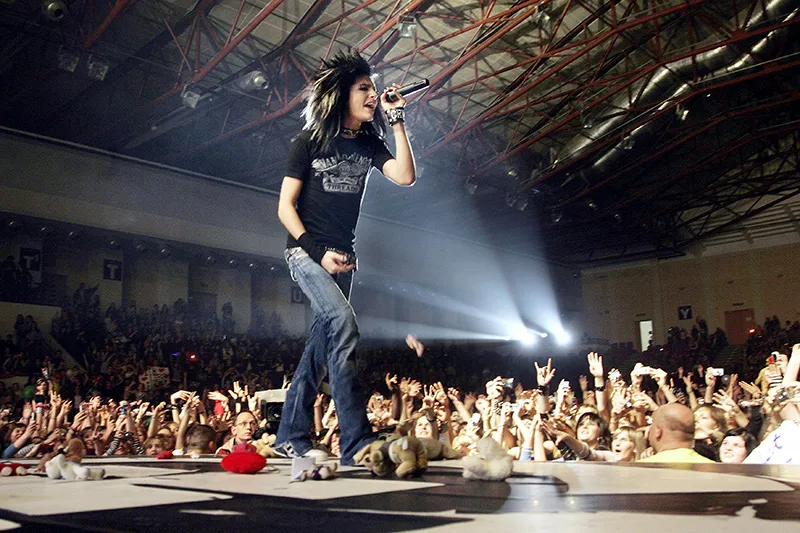
(Photo © 2007: DAVIDS/Sven Darmer - www.svendarmer.de)
Figure 4.7: The H-Blockx (with singer Henning Wehland at the microphone directly in front of the press photographers) at their concert on August 31, 2010 at the Zeltfestival Ruhr in Bochum/Witten. When the contact between musicians on stage and photographers in the press pit is so close, it is understandable that the photographers have to strictly adhere to the safety instructions issued by the organizer during accreditation! For example, it would be unthinkable if a photographer at this concert had placed his (or her) camera bag on the edge of the stage in order to be able to change lenses more quickly and conveniently ... Nikon D3S with 2.8/24-70 mm Micro Nikkor, with 26 mm focal length used. 1/320 second, Blender 2.8, ISO 5000.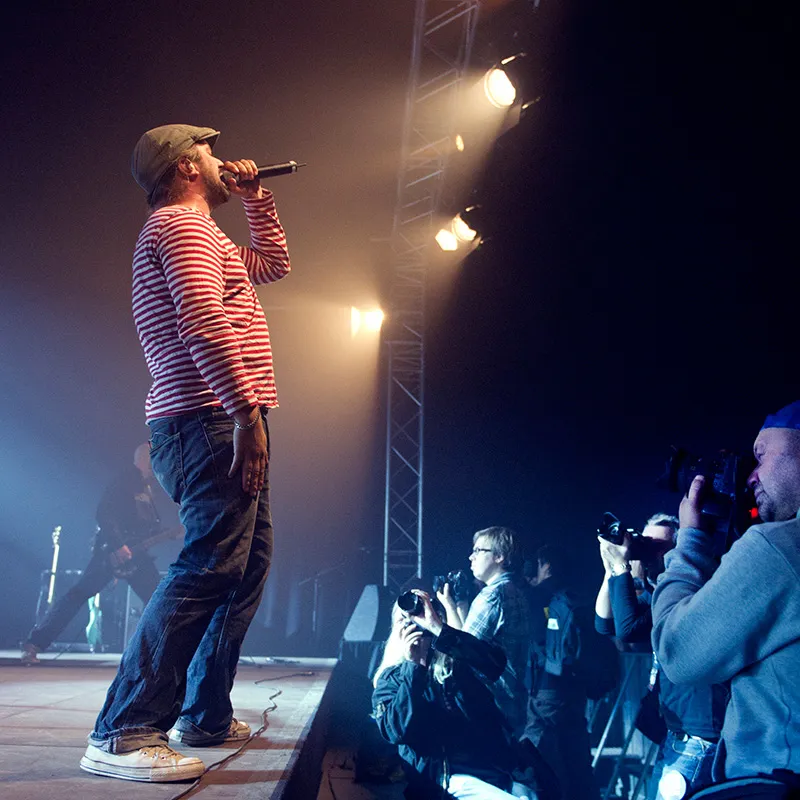
(Photo © 2010: Jens Brüggemann - www.jensbrueggemann.de)
4.4 Follow security instructions
Although concert organizers try to give photographers as much information and instructions as possible in advance about how to behave during the concert, they cannot look into the future and plan everything that will happen during the concert down to the last detail.
In order to be able to react flexibly to unexpected events (for example the outbreak of panic among some fans in the auditorium, fainting spells, smoke development, the throwing of objects from the audience, storming the stage, etc.) and to satisfy the (security) interests of the concert organizers, the accreditation always includes the information that the security, which monitors the course of events during the entire concert event, has absolute authority to issue instructions and that all photographers must strictly adhere to them.
Note
"As already mentioned, security is the extended arm of the organizer, who has the domiciliary rights. In this respect, the word of the security is law, whether you like it or not.
For reasons of practicability, it is usually not possible and also not sensible for the security to justify its instructions. Therefore, it often comes across as if the decisions are very arbitrary. However, every concert photographer should realize that the primary task of security is to maintain or restore the safety of all participants (...)."
(From: Konzertfotografie; Brüggemann, Becher, Meister, Darmer, Lippert; mitp Verlag 2012; 186 pages; 24.95 euros).
Figure 4.8: The (still) deserted press pit a few minutes before the concert begins. The photographers are not yet allowed to enter the pit; they have to wait until the security (an impressive representative can be seen on the left of the picture) gives the signal and opens the barriers for the accredited photographers. And then it usually starts within a very short time!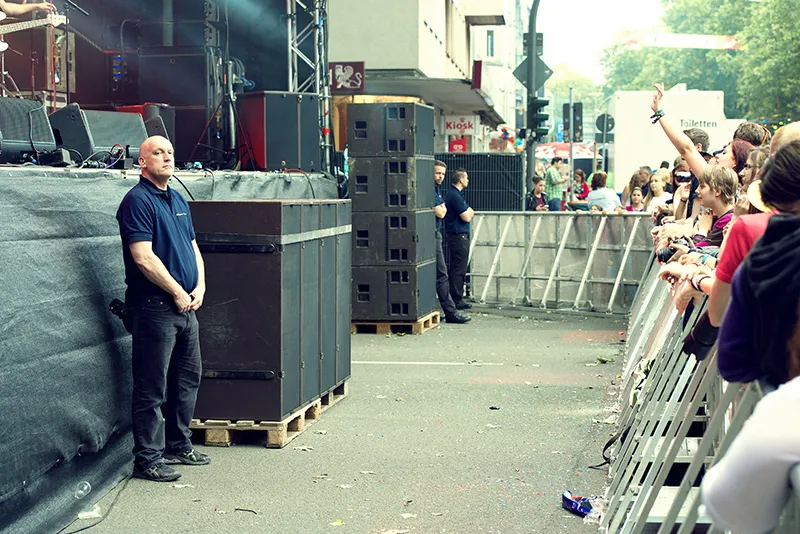
(Photo © 2013: Jens Brüggemann - www.jensbrueggemann.de)
With the help of modern communication methods ("button in ear"), the members of security are optimally networked with each other. This means that each of them can be informed as quickly as possible about events that take place outside their field of vision, for example at the other end of the concert hall, as security is ideally distributed throughout the concert venue. This means that the individual members are already aware of potentially dangerous situations, even if they are located somewhere else entirely.
For us concert photographers, this means that we must follow the instructions of security as quickly as possible. Because due to insider information that security has, but not us, it is often not clear to us what the reason for certain instructions are. However, the decisive factor is that security has an information advantage over us photographers and is also entitled to give us instructions. As a rule, these instructions are not arbitrary, but serve the safety of everyone involved and ensure that the concert runs smoothly.
Figure 4.9: Culcha Candela in concert on August 20, 2011. When totally enthusiastic fans in the audience hyperventilate or even faint at the sight of their idols, the paramedics need to be deployed quickly. Security then has to ensure a smooth rescue operation, which sometimes also means that the photographers have to clear the press pit quickly and at short notice to enable the paramedics to get through quickly and possibly rescue the unconscious person. Nikon D3S with 4.0/24-120mm Micro Nikkor, with 24mm focal length used. 1/100 second, Blender 5.0, ISO 2000.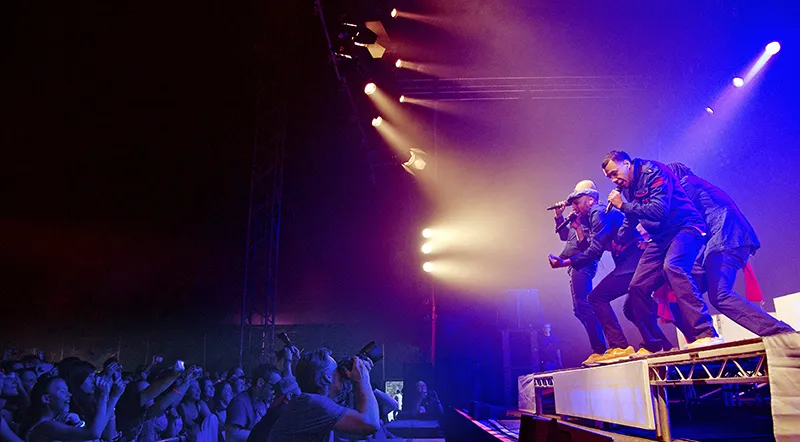
(Photo © 2011: Jens Brüggemann - www.jensbrueggemann.de)
Conclusion on the topic
When security gives instructions, you should follow them as quickly as possible and without discussion. Due to the telecommunication network of its members, security has more information than you do, so the instructions usually have a (security-relevant) background.
If you are a good partner in the press pit, security will also be sympathetic to the photographers and understand our concerns.
A brief greeting with eye contact and a nod when entering the pit creates a relaxed atmosphere and paves the way for a good working relationship.
If both sides respect the task/work of the other side and do not hinder it, but if possible even support it, then a cooperative relationship will develop, from which both sides can benefit again at the next concert.
On the other hand, anyone who is unpleasantly conspicuous in the press pit, does not immediately follow the instructions of the security and then argues with them will certainly never be supported and encouraged in their work of taking exceptional concert photos.
4.5 Act prudently
The press pit at the edge of the stage is often packed with event technology. There are not only speakers, but also lighting equipment and, of course, lots of cables. Ideally, these are well hidden, but I've also seen plenty of concerts where there was a tangle of cables at the edge of the pit, close to the stage. Such tripping hazards can be dangerous, especially because there is usually no light in the pit and the use of flashlights is generally prohibited for photographers.
Figure 4.10: Watch out for tripping hazards! The cables between the boxes are clearly visible here. However, the photo was taken at a high light sensitivity of 3,200 ISO and at a time when the pit was almost completely empty again. In the crowd, when many concert photographers are bustling around in the pit, cables hanging around or lying around are easily overlooked. Especially as we photographers, due to the short time available, only move around in the pit with the DSLR in front of our eyes facing the stage (and therefore ready to take pictures). So be careful, because a broken ankle doesn't just mean pain, but also absence from work for several weeks or even months!
(Photo © 2011: Jens Brüggemann - www.jensbrueggemann.de)
In addition, especially when events take place outdoors or in tents, there are sometimes depressions in the trench through which power cables are routed. It is very easy to stumble here, twist your ankle or even break it.
Conclusion: So be careful in the trench! Make sure that you leave the event site in one piece! It's best to keep an eye out for potential tripping hazards as soon as you enter the pit (shortly before the concert starts, it's usually still light enough in the venue). If in doubt, photographers should move a little more slowly and carefully - even in the hustle and bustle of the short photography period.
4.6 Do not leave any objects lying around in the pit
Due to the crowds and the confusing situation in the press trench, photographers should not leave anything lying around, but should carry everything (equipment, clothing, etc.) on their person. This sounds obvious, but the temptation is great to put down the photo backpack, for example, in order to be able to move around (more freely). Clothes, usually jackets, are also quickly discarded, because the air in the concert hall is usually stuffy and warm, so that even in a T-shirt you can start sweating, even if it is still below zero outside.
It is advisable to take a small, flat photo backpack with you to the concert and carry it on your back the whole time. This won't get in the way so much when turning around or changing locations.
Of course, it would be best if you could do without a backpack or photo bag altogether. But then you would have to work with two cameras equipped with different focal lengths, which also entails the risk of the camera hanging over your shoulder dangling around and getting in the way (or running the risk of being bumped and damaged).
Figure 4.11: Hard to believe, but true: My sturdy, waterproof "Ultralight" photo bag from Rimowa is almost 20 years old - and still in good shape. I bought it because I can even stand on it - something I've often used when I didn't have a ladder or any other way to get an elevated position for a shoot. In the concert pit, however, between all the hectic photographers, standing on my photo bag is too dangerous for me, because a bump would immediately sweep me off the bag. At concerts, I prefer to use one of my photo backpacks, because they get in the way the least.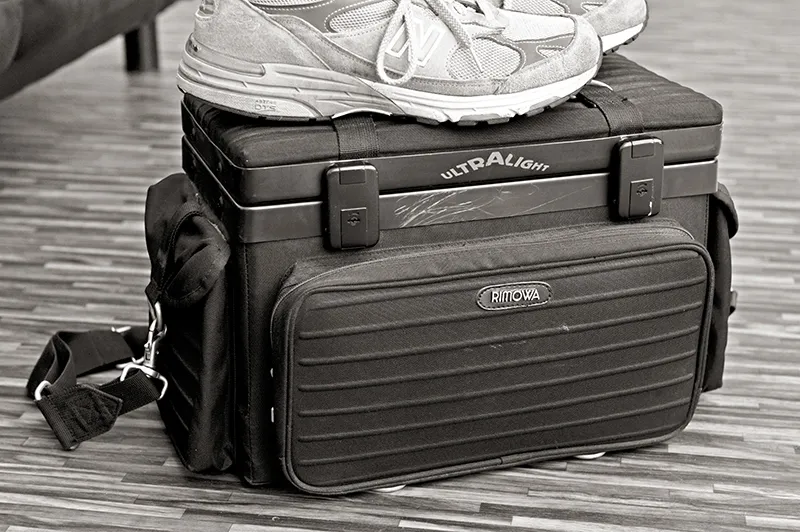
(Photo © 2012: Jens Brüggemann - www.jensbrueggemann.de)
Figure 4.12: U2 (here co-founder and singer Bono) at the concert in Berlin's Olympiastadion on July 7, 2005. In order to be able to move as freely as possible - if you are allowed to do so at all - it is advisable to photograph the concert with as little equipment as possible. It is not always necessary to have all the lenses with you; sometimes the "material battle" distracts you from concentrating on the subject.
If you can determine before the concert whether you will be standing very close to the stage or further away, you can pack suitable lenses. However, with a wide-angle zoom and a portrait telephoto lens, you are usually sufficiently equipped and prepared for almost all eventualities. This photo clearly shows the security in their red jackets, sometimes standing with their backs to the stage (which normal concert-goers would never do!).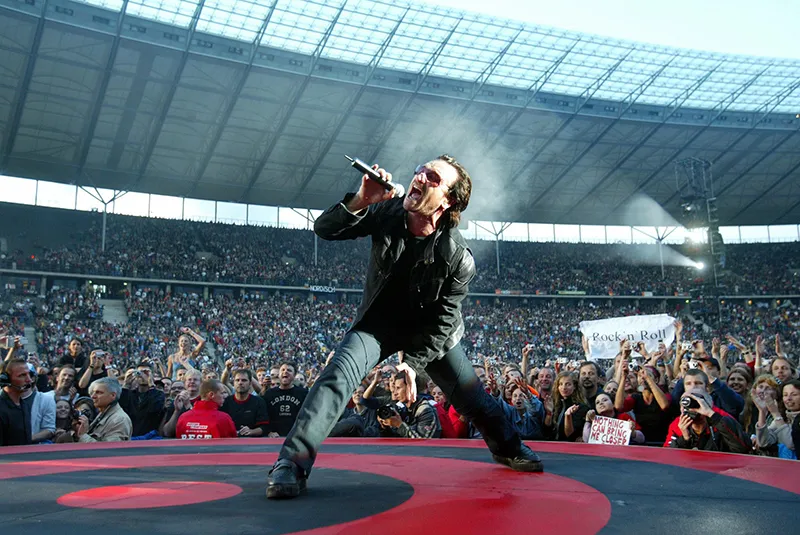
(Photo © 2007: DAVIDS/Sven Darmer - www.svendarmer.de)
